Decent Life Initiative and Sustainable Development Goals: A Systems Thinking Approach
Abstract
:1. Introduction
2. Decent Life Initiative
3. Methods
4. Results
4.1. Decent Life–Economic Feedback Loops
4.2. Decent Life–Social Feedback Loops
4.3. Decent Life–Environmental Feedback Loops
4.3.1. Outdoor Environmental Quality
- Air as a key element of Environmental Quality
- Water as a key element of Environmental Quality
4.3.2. Indoor Environmental Quality
5. Discussion
- Raising Awareness: To maximize and accelerate social impacts, the government should work hard to modify citizen behaviors towards the importance of education (Feedback loop R6), healthcare (Feedback loop R11), social engagement (Feedback loop R7), and training and capacity development (Feedback loop R15). To maximize and accelerate environmental impacts, social marketing can be a powerful tool for changing sustainable behavior [66], such as household solid waste recycling (Feedback loop R17). Also, Feedback loop R22 shows it is most effective and can also play an important role in rationalizing the consumption of water.
- Adopting Technology: Utilizing advanced technology in providing the economic infrastructure, including telecommunications services (Feedback loop R4), energy supplies (Feedback loop R2), roads and transportation services (Feedback loop R3), and finance and insurance services (Feedback loop R1) plays a vital role in enabling the Egyptian government to enhance these services. It is worth noting that acquiring advanced technology may have high initial costs in the short run; however, it provides high-cost savings in the long run. Technology can play a role in solving environmental problems, although structural measures are also required if we are to realize a future sustainable society. Feedback loops R18 and R19 show that applying technology for using biogas units will improve the environment through clean energy production and organic farming.
- Policies and legislations: The Egyptian government may issue policies and legislation that facilitate doing business in Egypt. These policies and legislations include facilitating the procedures needed to start a new business, removing the barriers and obstacles faced by firms that are working in the Egyptian markets, and giving incentives to encourage firms to increase their investments in Egypt such as lower taxes and lower interest rates on business loans (Feedback loop R1). Also, there is an important need for environmental legislation to protect water canals (Feedback loop R20).
6. Conclusions
Author Contributions
Funding
Data Availability Statement
Conflicts of Interest
References
- International Institute for Sustainable Development, “Sustainable Development”. Available online: https://www.iisd.org/mission-and-goals/sustainable-development (accessed on 23 August 2023).
- Hardt, L.; O’Neill, D. Ecological macroeconomic models: Assessing current developments. Ecol. Econ. 2017, 143, 198–211. [Google Scholar] [CrossRef]
- Yang, Z.; Gao, W.; Li, J. Can Economic Growth and Environmental Protection Achieve a “Win–Win” Situation? Empirical Evidence from China. Int. J. Environ. Res. Public Health 2022, 19, 9851. [Google Scholar] [CrossRef]
- Department for International Development. Investing in Sustainable Growth and Poverty Reduction: A Practical guide to the Economics of Sustainable Development; DFID: London, UK, 2008. [Google Scholar]
- Yang, M.; Chen, L.; Wang, J.; Msigwa, G.; Osman, A.I.; Fawzy, S.; Rooney, D.W.; Yap, P.S. Circular Economy Strategies for Combating Climate Change And Other Environmental Issues. Environ. Chem. Lett. 2023, 21, 55–80. [Google Scholar] [CrossRef]
- International Energy Agency. World Energy Outlook; OECD/IEA: Paris, France, 2020. [Google Scholar]
- Hauschild, M.Z.; Kara, S.; Røpke, I. Absolute sustainability: Challenges to life cycle engineering. CIRP Ann. 2020, 69, 533–553. [Google Scholar] [CrossRef]
- Bank, T.W. Systems Thinking for Policy Analysis; The World Bank: Washington, DC, USA, 2013. [Google Scholar]
- Programme, U.N.E. Sustainable Development Goals: A Systems Approach; United Nations Environment Programme: Nairobi, Kenya, 2015. [Google Scholar]
- Bill and Melinda Gates. Foundation, Systems Thinking for Global Health; Bill and Melinda Gates Foundation: Seattle, WA, USA, 2016. [Google Scholar]
- Dragicevic, A.; Shogren, J. Preservation Value in Socio-Ecological Systems. Ecol. Model. 2021, 443, 109451. [Google Scholar] [CrossRef]
- El-Sherbini, A.M.; Shalaby, A.A. The impact of youth migration on rural development in Egypt. J. Rural. Stud. 2018, 62, 134–144. [Google Scholar]
- CAPMAS. CAPMAS’s Survey of Income, Expenditure and Consumption for 2017/2018 and 2019/2020; CAPMAS: Cairo, Egypt, 2020. [Google Scholar]
- Soliman, A.; Larson, G. Building Infrastructure and Social Capital in Rural Egypt. In Agricultural and Rural Development Notes; World Bank: Washington, DC, USA, 2007; Available online: http://hdl.handle.net/10986/9563 (accessed on 23 August 2023).
- Elmenofi, G.; El Bilali, H.; Berjan, S. Governance of rural development in Egypt. Ann. Agric. Sci. 2014, 59, 285–296. [Google Scholar] [CrossRef]
- Radwan, M.; Ramadan, M. Effectiveness of Decent Life Initiative in Kafr Shebin Village, Qalyubia Governorate. Menoufia J. Agric. Econ. Soc. Sci. 2021, 6, 249–270. (In Arabic) [Google Scholar]
- Ministry of Planning and Economic Development. Egypt Human Development Report 2021; UNDP: New York, NY, USA, 2021; Available online: https://www.undp.org/egypt/egypt-human-development-report-2021 (accessed on 23 August 2023).
- Benavides, R.M.; Gaona, R.C.; Guerrero, H.S.; Patiño, L.A.A.G. Sustainable feedbacks of Colombian paramos involving livestock, agricultural activities, and sustainable development goals of the agenda 2030. Systems 2019, 7, 52. [Google Scholar] [CrossRef]
- Ghaz, I.A. Decent life. The applied model of social safety nets in the balance of the sustainable development plan. Bus. Adm. 2021, 175, 8–13. (In Arabic) [Google Scholar]
- Duić, N.; Urbaniec, K.; Huisingh, D. Components and structures of the pillars of sustainability. J. Clean. Prod. 2015, 88, 1–12. [Google Scholar] [CrossRef]
- Purvis, B.; Mao, Y.; Robinson, D. Three pillars of sustainability: In search of conceptual origins. Sustain. Sci. 2019, 14, 681–695. [Google Scholar] [CrossRef]
- Boussemart, J.P.; Leleu, H.; Shen, Z.; Valdmanis, V. Performance analysis for three pillars of sustainability. J. Product. Anal. 2020, 53, 305–320. [Google Scholar] [CrossRef]
- Ministry of Planning and Economic Development. Follow-Up and Evaluation of the Executive Position of the First phase Report. Available online: https://mped.gov.eg/singlenews?id=242&lang=en (accessed on 20 June 2023).
- Department of Economic and Social Affairs, United Nations. Egypt SDGs. Available online: https://sdgs.un.org/partnerships/decent-life-hayah-kareema-sustainable-rural-communities (accessed on 20 August 2023).
- Montreal College of Information Technology (MCIT). Presidential Initiative “a Decent Life”. 2022. Available online: https://mcit.gov.eg/ar/decent_life (accessed on 1 September 2022).
- Lacitignola, D.; Petrosillo, I.; Cataldi, M.; Zurlini, G. Modelling socio-ecological tourism-based systems for sustainability. Ecol. Model. 2007, 206, 191–204. [Google Scholar] [CrossRef]
- Wheeldon, J.; Ahlberg, M. Mind Maps in Qualitative Research. In Handbook of Research Methods in Health Social Sciences; Liamputtong, P., Ed.; Springer: Singapore, 2019. [Google Scholar]
- Haraldsson, H. Introduction to Systems Thinking and Causal Loop Diagrams; Lund University: Lund, Sweden, 2004. [Google Scholar]
- Youssef, M. Assessment of Poverty Alleviation Policies in Assiut Governorate, Egypt. In Institutional Reforms, Governance, and Services Delivery in the Global South; Palgrave Macmillan: Cham, Switzerland, 2022; pp. 265–287. [Google Scholar]
- Adams, R. Nonfarm Income, Inequality, and Poverty in Rural Egypt and Jordan; Policy Research Working Paper; World Bank Publications: Herndon, VA, USA, 2001; Volume 2572. [Google Scholar]
- Armanious, D. Accelerating global actions for a world without poverty: Egypt Experience. In Faculty of Economics and Political Science; Cairo University: Cairo, Egypt, 2021. [Google Scholar]
- Farag, A. A Decent Life and the Future of the Egyptian Village in the New Republic. Al Democr. 2021, 21, 45–49. (In Arabic) [Google Scholar]
- United Nations. Social Perspectives on Development. 2022. Available online: https://www.un.org/development/desa/socialperspectiveondevelopment/issues/poverty-eradication.html (accessed on 17 July 2023).
- Salonen, A.; Åhlberg, M. Sustainability in everyday life: Integrating environmental, social, and economic goals. Sustain. J. Rec. 2011, 4, 134–142. [Google Scholar] [CrossRef]
- Dragicevic, A.Z. Deconstructing sustainability. Sustain. Dev. 2018, 26, 525–532. [Google Scholar] [CrossRef]
- Grum, B.; Kobal, G.D. Concepts of social sustainability based on social infrastructure and quality of life. Facilities 2020, 38, 783–800. [Google Scholar] [CrossRef]
- Hull, K. Understanding the relationship between economic growth, employment and poverty reduction. Promot. Pro-Poor Growth Employ. 2009, 1, 69–94. [Google Scholar]
- Prasad, C.; Gupta, P. Educational Impact on the Society. Int. J. Nov. Res. Educ. Learn. 2020, 7, 1–7. [Google Scholar]
- Milton, B.; Attree, P.; French, B.; Povall, S.; Whitehead, M.; Popay, J. The impact of community engagement on health and social outcomes: A systematic review. Community Dev. J. 2012, 47, 316–334. [Google Scholar] [CrossRef]
- RMahadevan; Hoang, V. Is There a Link Between Poverty and Food Security? Soc. Indic. Res. 2016, 128, 179–199. [Google Scholar] [CrossRef]
- Miller, J.D.; Workman, C.L.; Panchang, S.V.; Sneegas, G.; Adams, E.A.; Young, S.L.; Thompson, A. Water security and nutrition: Current knowledge and research opportunities. Adv. Nutr. 2021, 12, 2525–2539. [Google Scholar] [CrossRef] [PubMed]
- Jenkinson, C. Quality of Life; Encyclopedia Britannica: Edinburgh, UK, 2023; Available online: https://www.britannica.com/topic/quality-of-life (accessed on 10 June 2023).
- Abrams, L.; Friedman, K.; Maestas, N. The role of physical and cognitive/emotional functioning in the associations between common health conditions and working. Soc. Sci. Med. 2023, 322, 115816. [Google Scholar] [CrossRef] [PubMed]
- González-Blanch, C.; Hernández-de-Hita, F.; Muñoz-Navarro, R.; Ruíz-Rodríguez, P.; Medrano, L.A.; Cano-Vindel, A. The association between different domains of quality of life and symptoms in primary care patients with emotional disorders. Sci. Rep. 2018, 8, 11180. [Google Scholar] [CrossRef]
- Chetty, R.; Hendren, N.; Kline, P.; Saez, E. Where is the Land of Opportunity? The Geography of Intergenerational Mobility in the United States. Q. J. Econ. 2014, 129, 1553–1623. [Google Scholar] [CrossRef]
- OECD. Green Growth and Developing Countries: A Summary for Policy Makers; OECD: Paris, France, 2012; Available online: https://www.oecd.org/greengrowth/green-development/50526354.pdf (accessed on 23 August 2023).
- Johnson, D.; Ambrose, S.; Bassett, T.; Bowen, M.; Crummey, D.; Isaacson, J.; Johnson, D.; Lamb, P.; Saul, M.; Winter-Nelson, E. Meanings of Environmental Terms. J. Environ. Qual. 1997, 26, 581–589. [Google Scholar] [CrossRef]
- Eusuf, M.; Mohit, M.; Eusuf, M.; Ibrahim, M. Impact of Outdoor Environment to the Quality of Life. Procedia-Soc. Behav. Sci. 2014, 153, 639–654. [Google Scholar] [CrossRef]
- World Meteorological Organization. Chapter One: Scientific Assessment of Ozone Depletion. In Controlled Substances and Other Source Gases; United Nations Environment Program: Genève, Switzerland, 2002. [Google Scholar]
- Clark, A.; McIntyre, A.; Lester, J.; Perry, R. Air Quality Impact Assessment. Environ. Monit. Assess. 1984, 4, 205–232. [Google Scholar] [CrossRef]
- Debrah, J.; Vidal, D.; Dinis, M. Raising awareness on solid waste management through formal education for sustainability: A developing countries evidence review. Recycling 2021, 6, 6. [Google Scholar] [CrossRef]
- Milik, S. Assessment of Solid Waste Management in Egypt during the Last Decade in Light of the Partnership between the Egyptian Government and the Private Sector; The American University in Cairo AUC: Cairo, Egypt, 2021. [Google Scholar]
- Peng, X.; Jiang, Y.; Chen, Z.; Osman, A.; Farghali, M.; Rooney, D.; Yap, P. Recycling municipal, agricultural and industrial waste into energy, fertilizers, food and construction materials, and economic feasibility: A review. Environ. Chem. Lett. 2023, 21, 765–801. [Google Scholar] [CrossRef]
- Rekleitis, G.; Haralambous, K.; Loizidou, M.; Aravossis, K. Utilization of agricultural and livestock waste in anaerobic digestion (AD): Applying the biorefinery concept in a circular economy. Energies 2020, 13, 4428. [Google Scholar] [CrossRef]
- Evans, R.; Sadler, E. Methods and technologies to improve efficiency of water use. Water Resour. Res. 2008, 44, 1–15. [Google Scholar] [CrossRef]
- Kulkarni, S. Innovative technologies for water saving in irrigated agriculture. Int. J. Water Resour. Arid. Environ. 2011, 1, 226–231. [Google Scholar]
- Khandelwal, H.; Dhar, H.; Thalla, A.; Kumar, S. Application of life cycle assessment in municipal solid waste management: A worldwide critical review. J. Clean. Prod. 2019, 209, 630–654. [Google Scholar] [CrossRef]
- Marzouk, M.; Azab, S. Environmental and economic impact assessment of construction and demolition waste disposal using system dynamics. Resour. Conserv. Recycl. 2014, 82, 41–49. [Google Scholar] [CrossRef]
- Bahgat, R.; Reffat, R.; Elkady, S. Analyzing the impact of design configurations of urban features on reducing solar radiation. J. Build. Eng. 2020, 32, 101664. [Google Scholar] [CrossRef]
- Pasten, C.; Santamarina, J. Energy and quality of life. Energy Policy 2012, 49, 468–476. [Google Scholar] [CrossRef]
- Arif, M.; Katafygiotou, M.; Mazroei, A.; Kaushik, A.; Elsarrag, E. Impact of indoor environmental quality on occupant well-being and comfort: A review of the literature. Int. J. Sustain. Built Environ. 2016, 5, 1–11. [Google Scholar]
- Iizuka, M. Role of Environmental Awareness in Achieving Sustainable Development; Economic Commission for Latin America and the Caribbean: Santiago, Chile, 2016; Available online: https://repositorio.cepal.org/bitstream/handle/11362/31562/1/S00111003_en.pdf (accessed on 23 August 2023).
- Abouaiana, A. Rural Energy Communities as Pillar towards Low Carbon Future in Egypt: Beyond COP27. Land 2022, 11, 2237. [Google Scholar] [CrossRef]
- Salah, S.; Eltaweel, M.; Abeykoon, C. Towards a sustainable energy future for Egypt: A systematic review of renewable energy sources, technologies, challenges, and recommendations. Clean. Eng. Technol. 2022, 8, 100497. [Google Scholar] [CrossRef]
- UNDP. Human Development Report 2021; United Nations Development Programme: New York, NY, USA, 2021. [Google Scholar]
- Namcy, R.L. Policymaking for Citizen Behavior Change: A Social Marketing Approach; Routledge: New York, NY, USA, 2017. [Google Scholar]
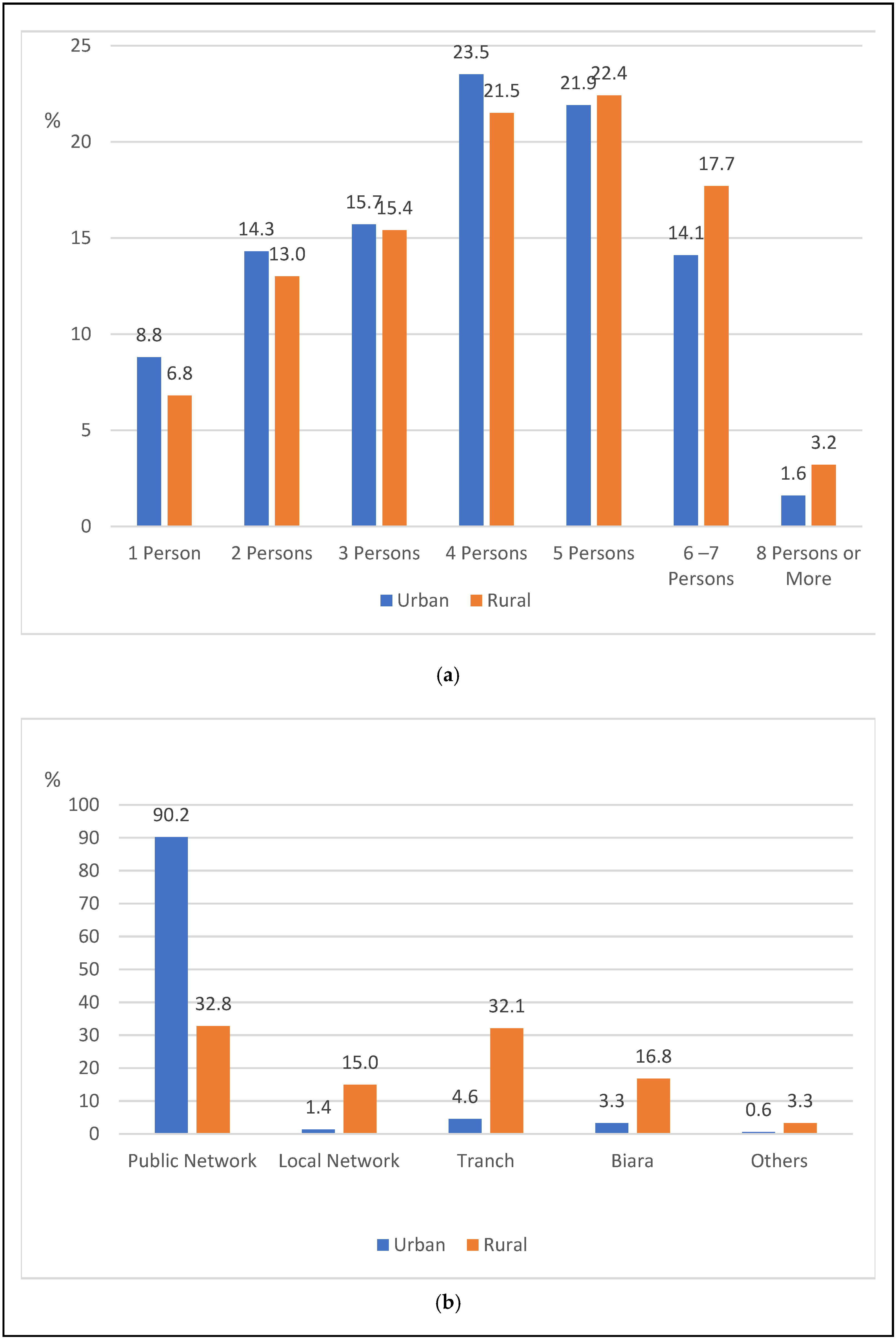
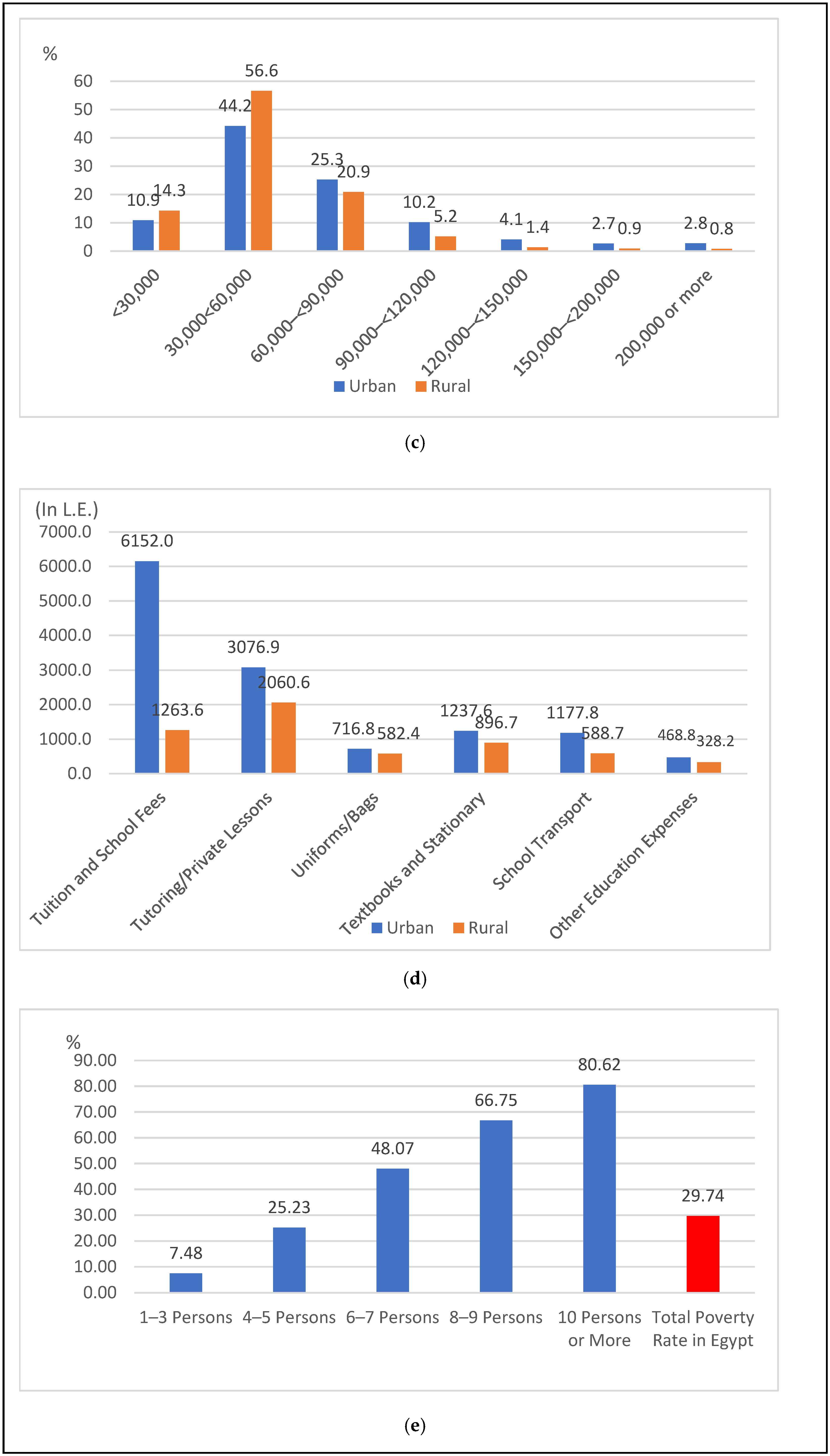
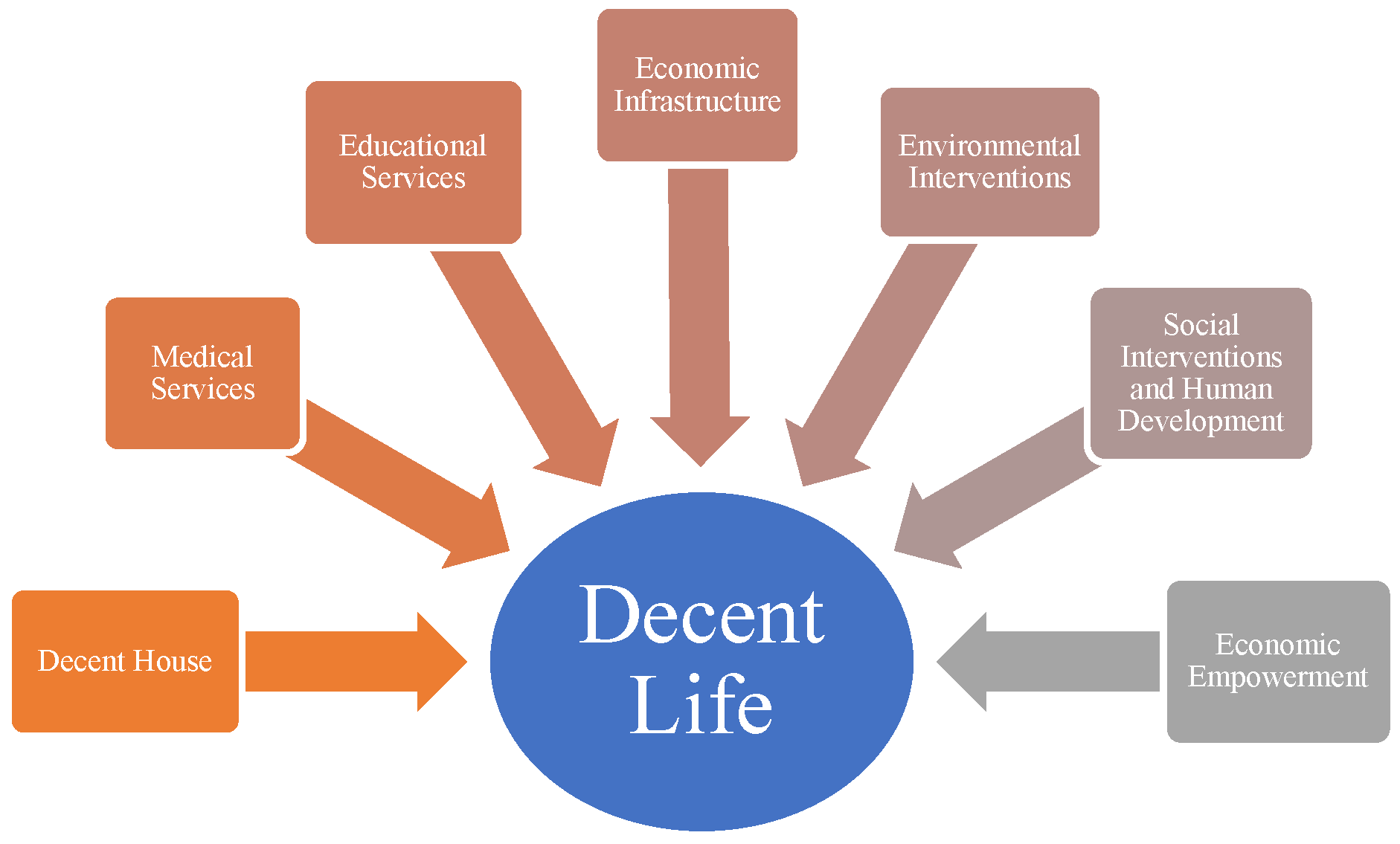
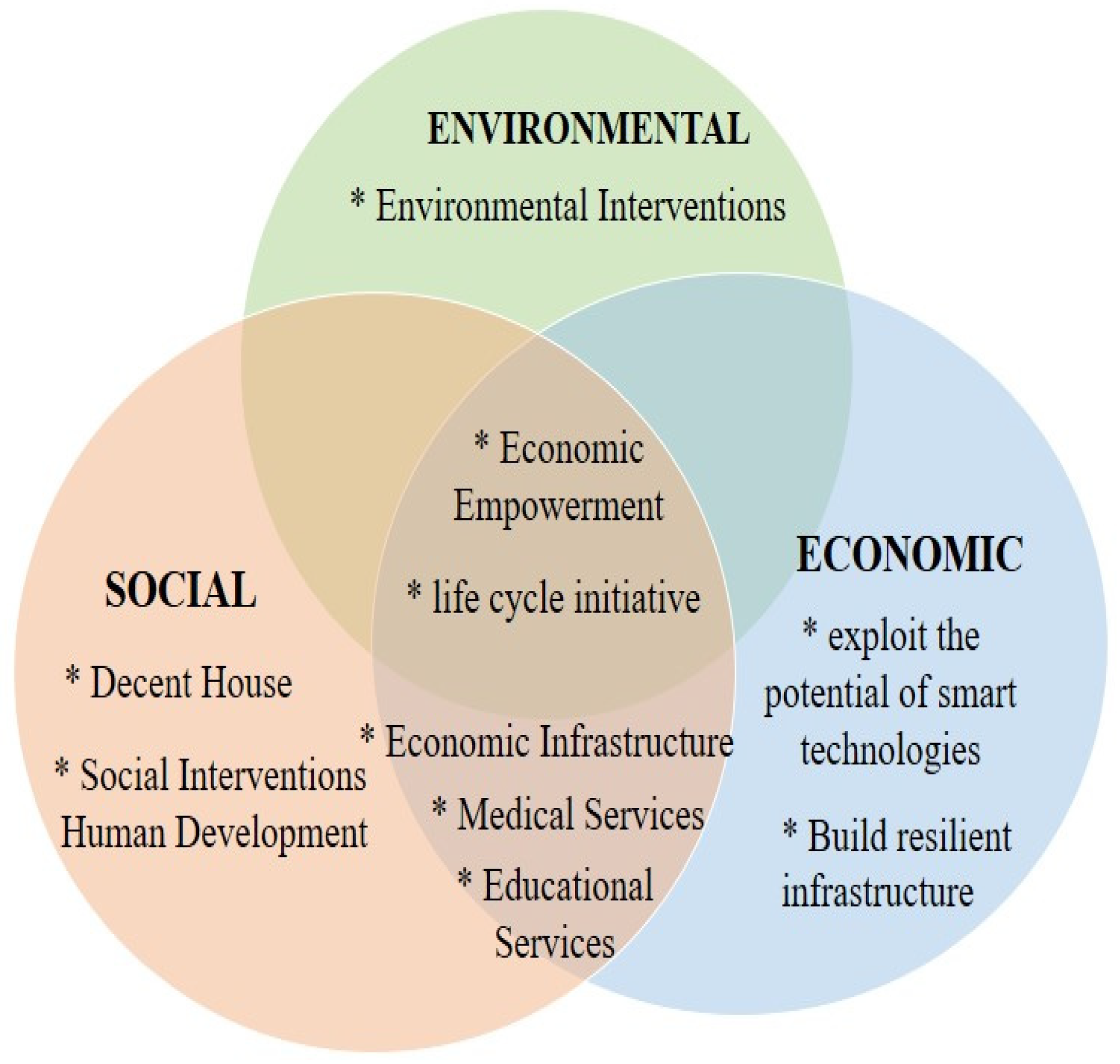

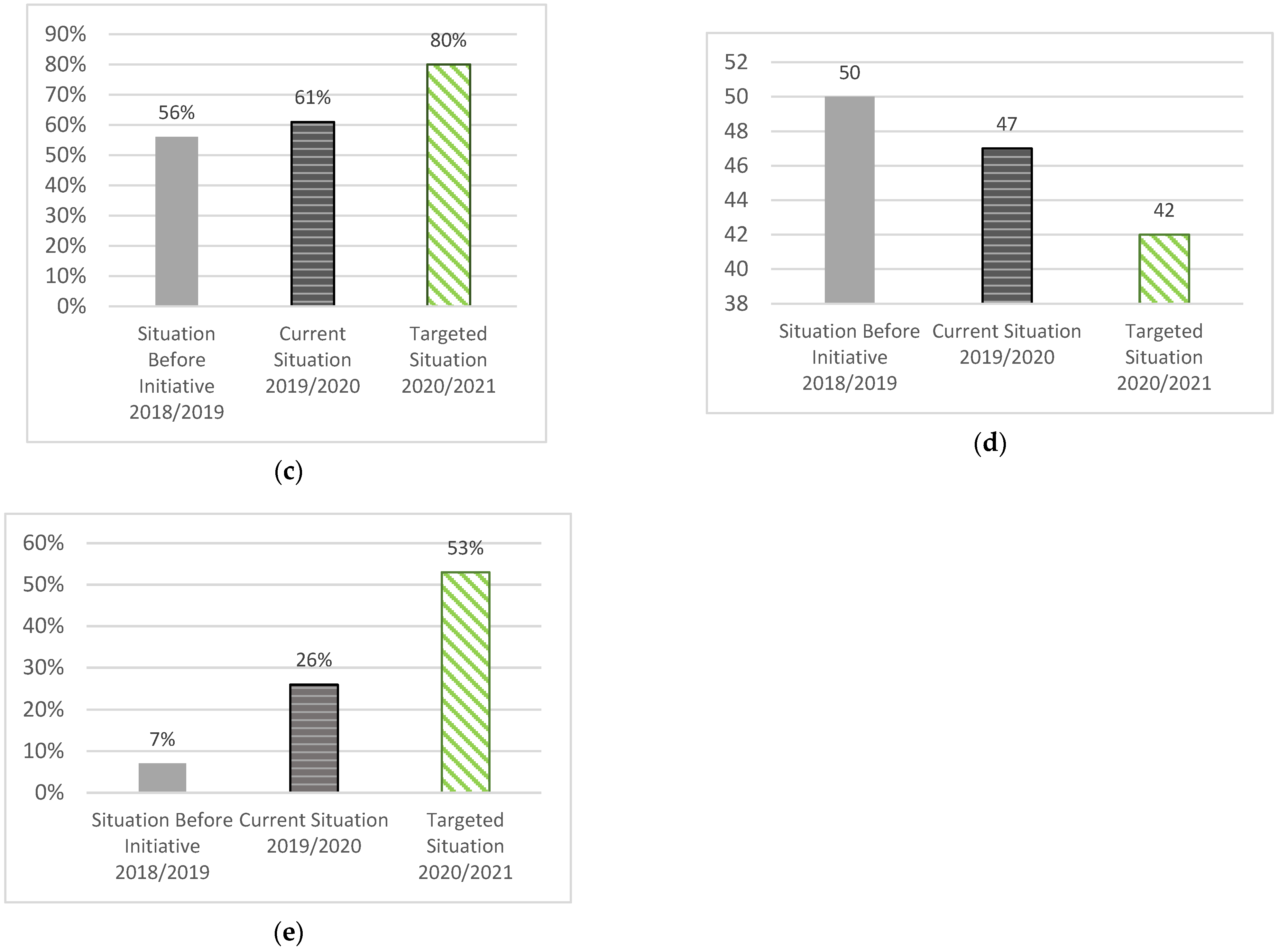

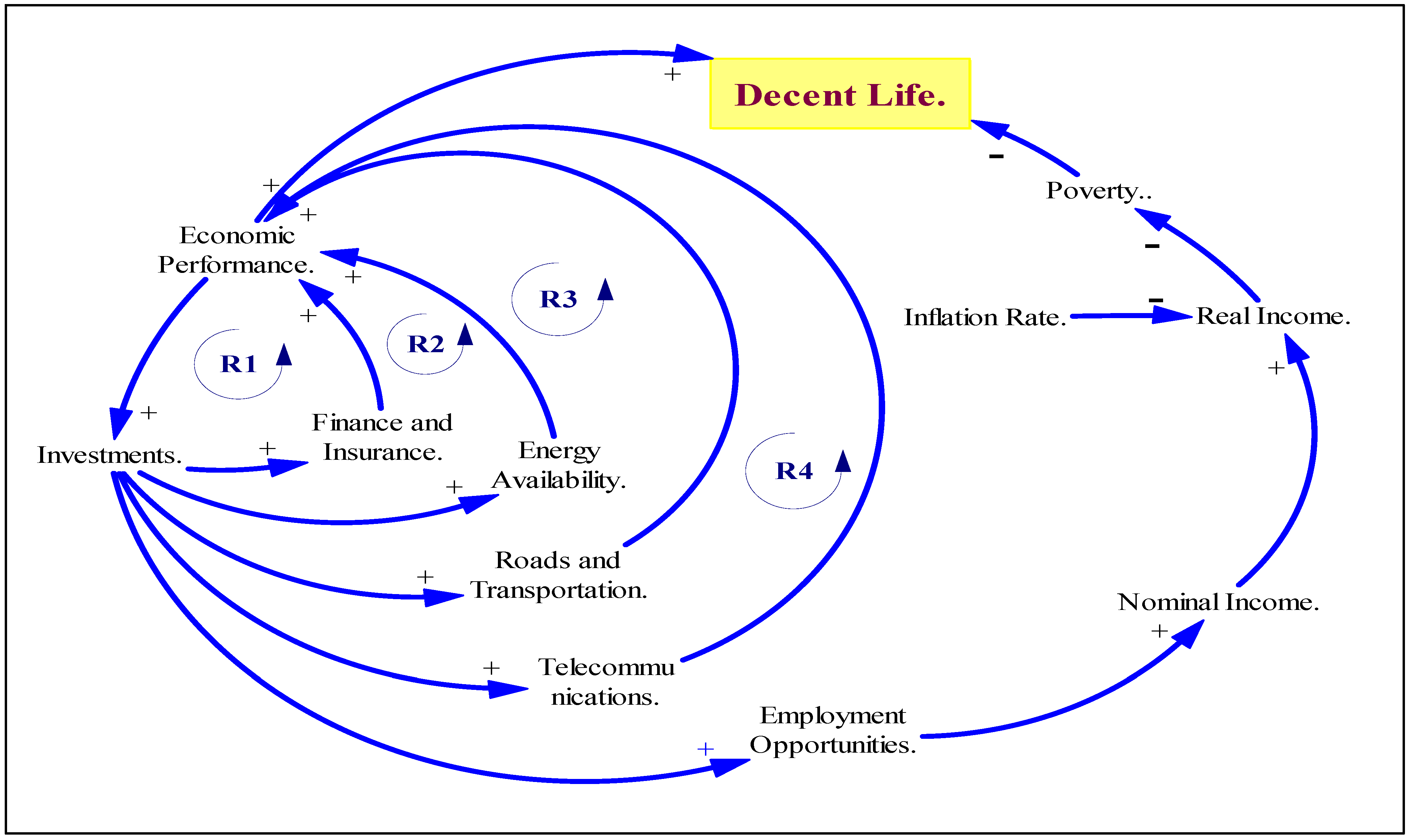
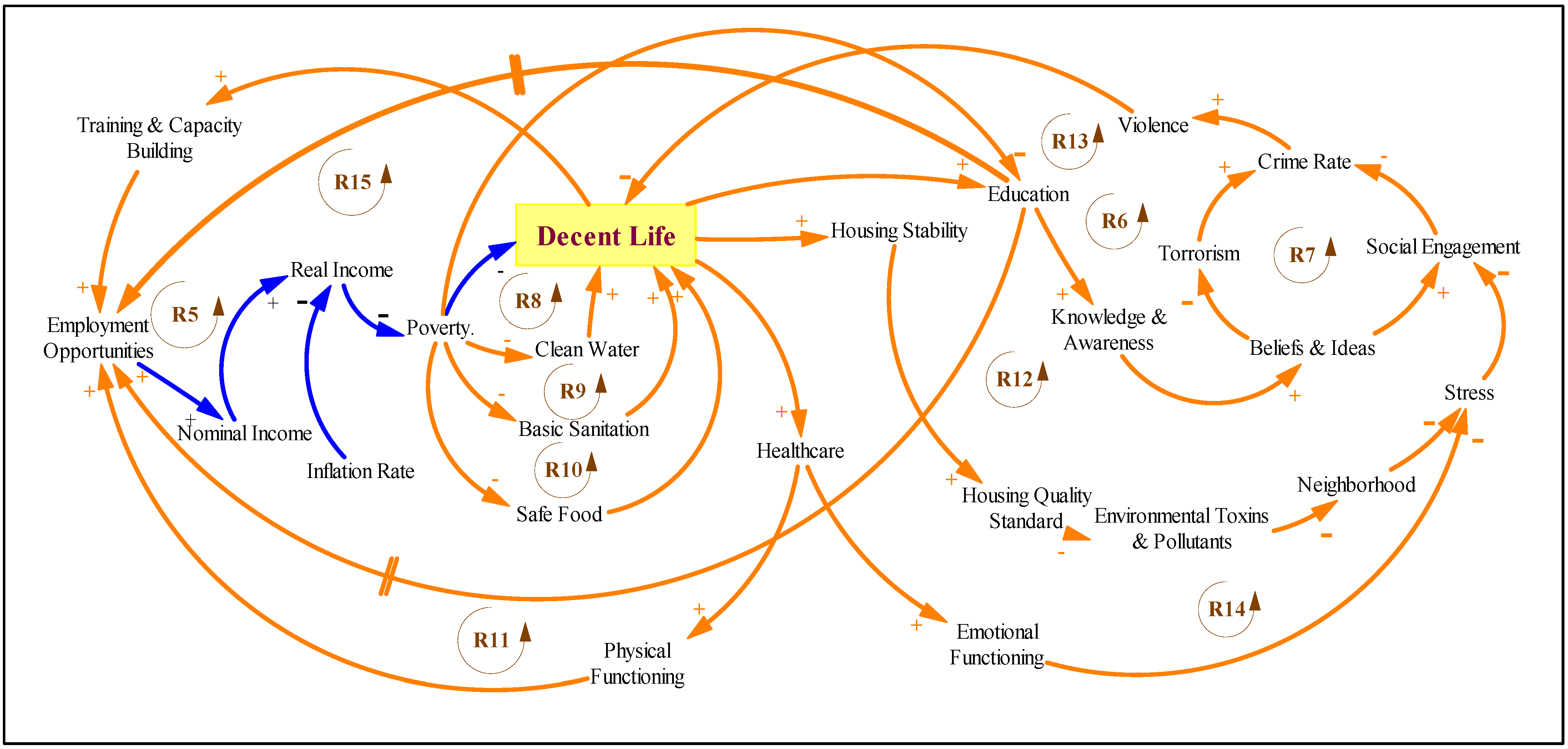
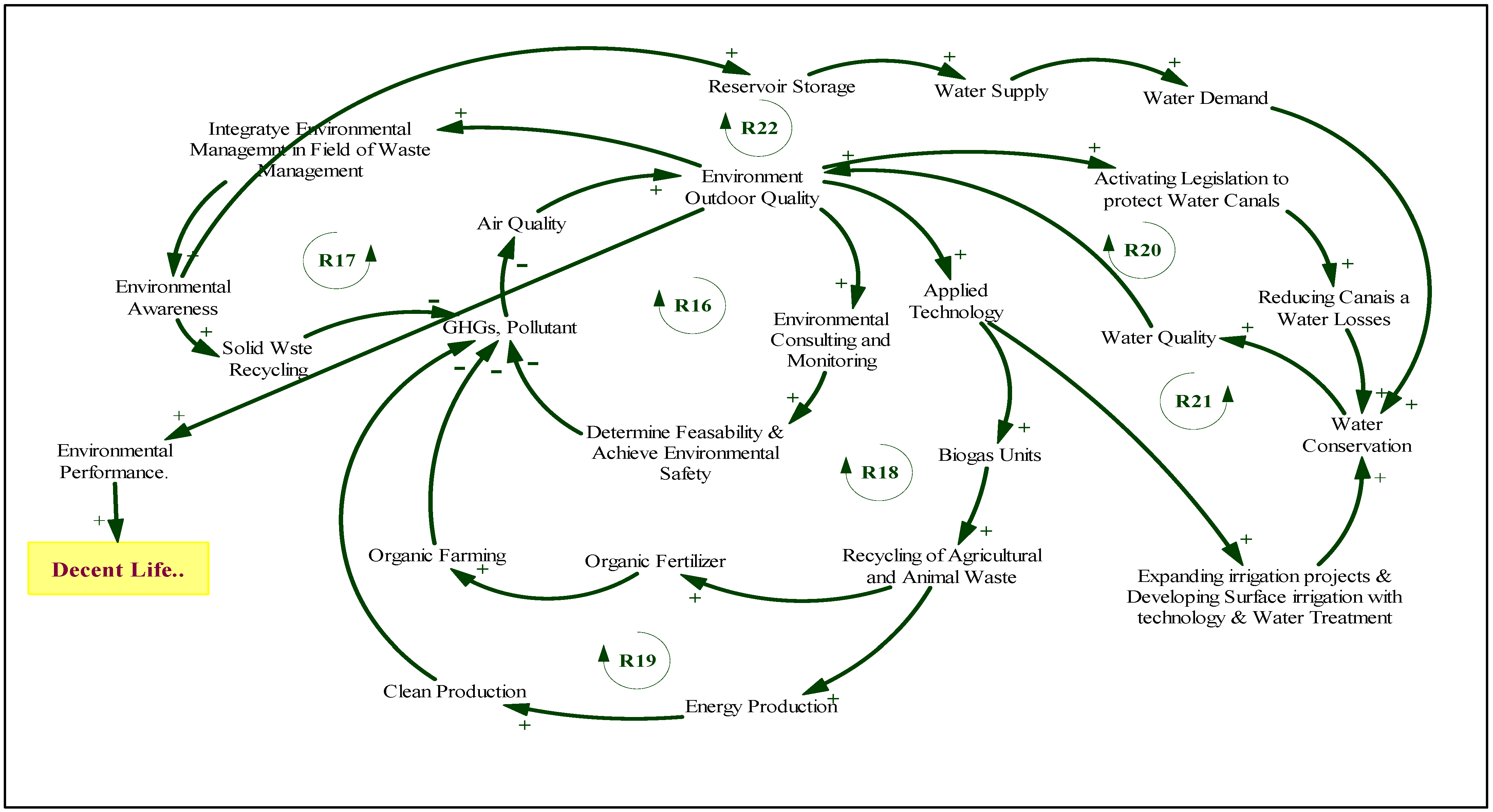
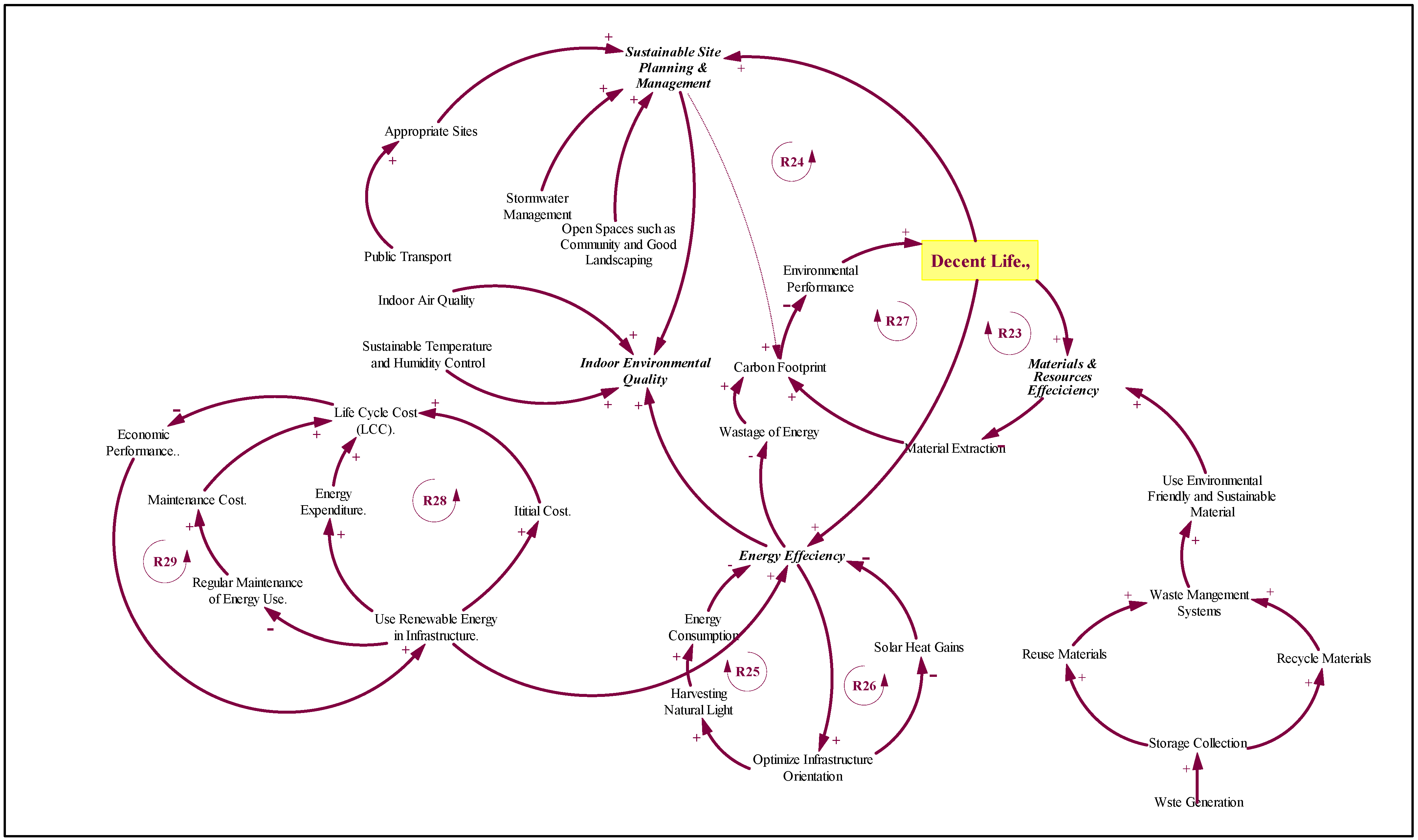
| Reinforce Loop | Sustainable Development Goal |
|---|---|
| R(1) & R(2) & R(3) & R(4) | Goal (9): Industry, Innovation, and Infrastructure |
| R(5) & R(13) | Goal (1): No Poverty |
| R(6) & R(7) & R(13) | Goal (4): Quality Education |
| R(8) | Goal (2): Zero Hunger |
| R (9) & R(10) & R(20) & R(21) & R(22) | Goal (6): Clean Water and Sanitation |
| R(11) & R(14) | Goal (3): Good Health and Well-being |
| R(12) & R(24) | Goal (11): Sustainable Cities and Communities |
| R (15) | Goal (8): Decent Work and Economic Growth |
| R(16) & R(23) | Goal (13): Climate Action |
| R(17) & R(18) & R(19) & R(25) & R(26) & R(27) | Goal (7): Affordable and Clean Energy |
Disclaimer/Publisher’s Note: The statements, opinions and data contained in all publications are solely those of the individual author(s) and contributor(s) and not of MDPI and/or the editor(s). MDPI and/or the editor(s) disclaim responsibility for any injury to people or property resulting from any ideas, methods, instructions or products referred to in the content. |
© 2023 by the authors. Licensee MDPI, Basel, Switzerland. This article is an open access article distributed under the terms and conditions of the Creative Commons Attribution (CC BY) license (https://creativecommons.org/licenses/by/4.0/).
Share and Cite
Azab, S.; Rabie, A.E.; Hafez, F.; Mostafa, A.H.; El Rayes, A.H.; Awad, M.M. Decent Life Initiative and Sustainable Development Goals: A Systems Thinking Approach. Systems 2023, 11, 446. https://doi.org/10.3390/systems11090446
Azab S, Rabie AE, Hafez F, Mostafa AH, El Rayes AH, Awad MM. Decent Life Initiative and Sustainable Development Goals: A Systems Thinking Approach. Systems. 2023; 11(9):446. https://doi.org/10.3390/systems11090446
Chicago/Turabian StyleAzab, Shimaa, Aya Ebrahim Rabie, Fatma Hafez, Asmaa Hamdy Mostafa, Amani Helmi El Rayes, and Mai Mostafa Awad. 2023. "Decent Life Initiative and Sustainable Development Goals: A Systems Thinking Approach" Systems 11, no. 9: 446. https://doi.org/10.3390/systems11090446
APA StyleAzab, S., Rabie, A. E., Hafez, F., Mostafa, A. H., El Rayes, A. H., & Awad, M. M. (2023). Decent Life Initiative and Sustainable Development Goals: A Systems Thinking Approach. Systems, 11(9), 446. https://doi.org/10.3390/systems11090446






